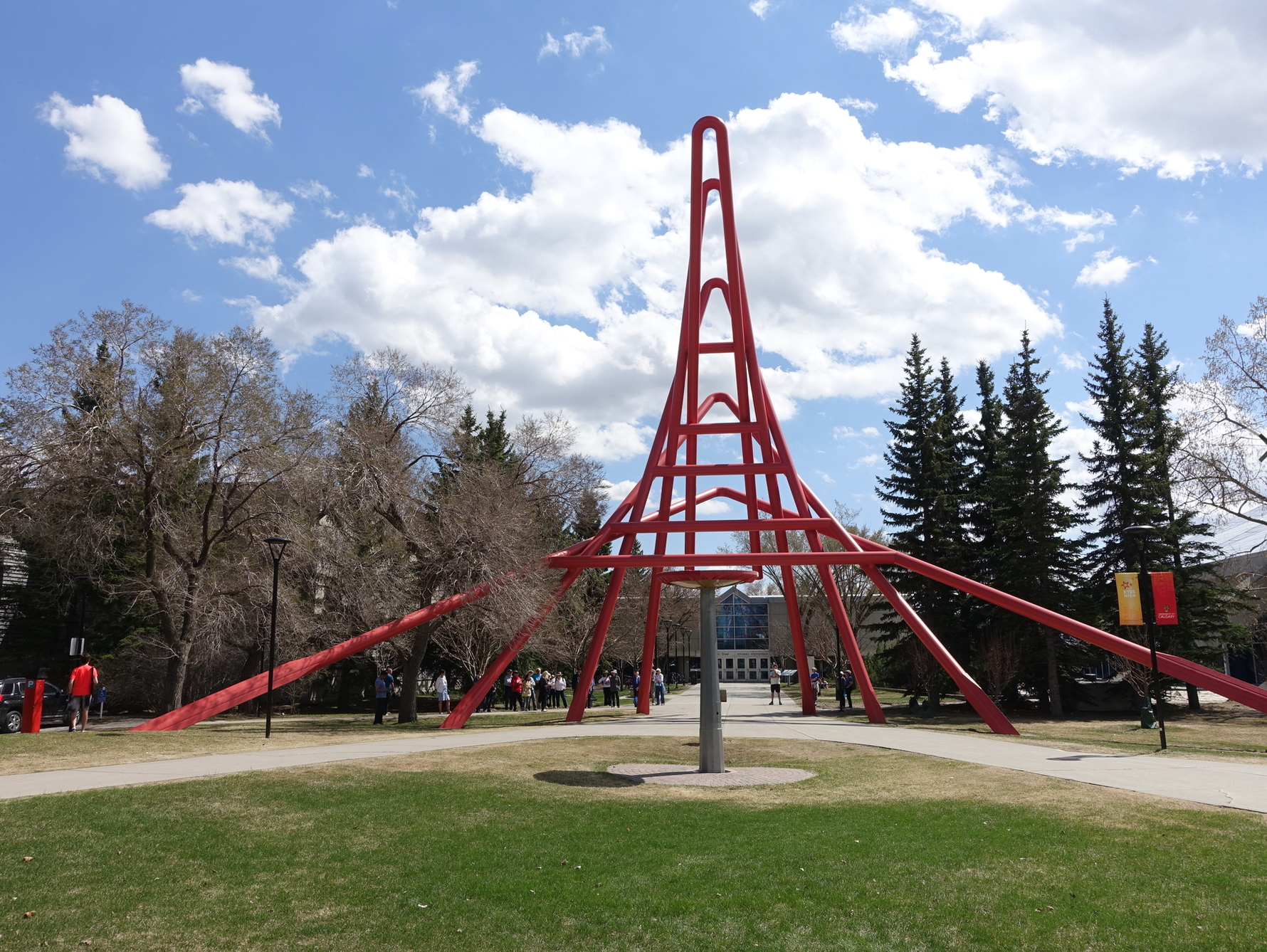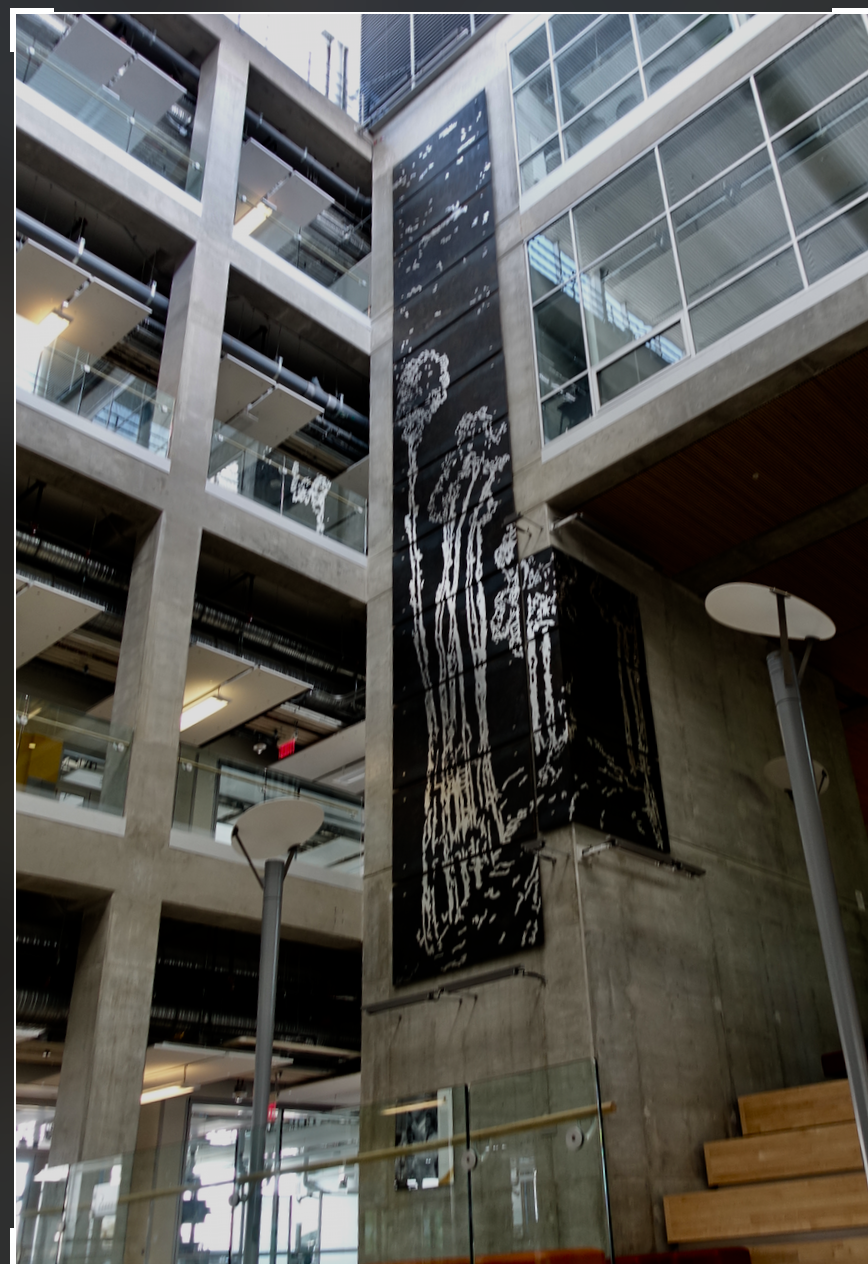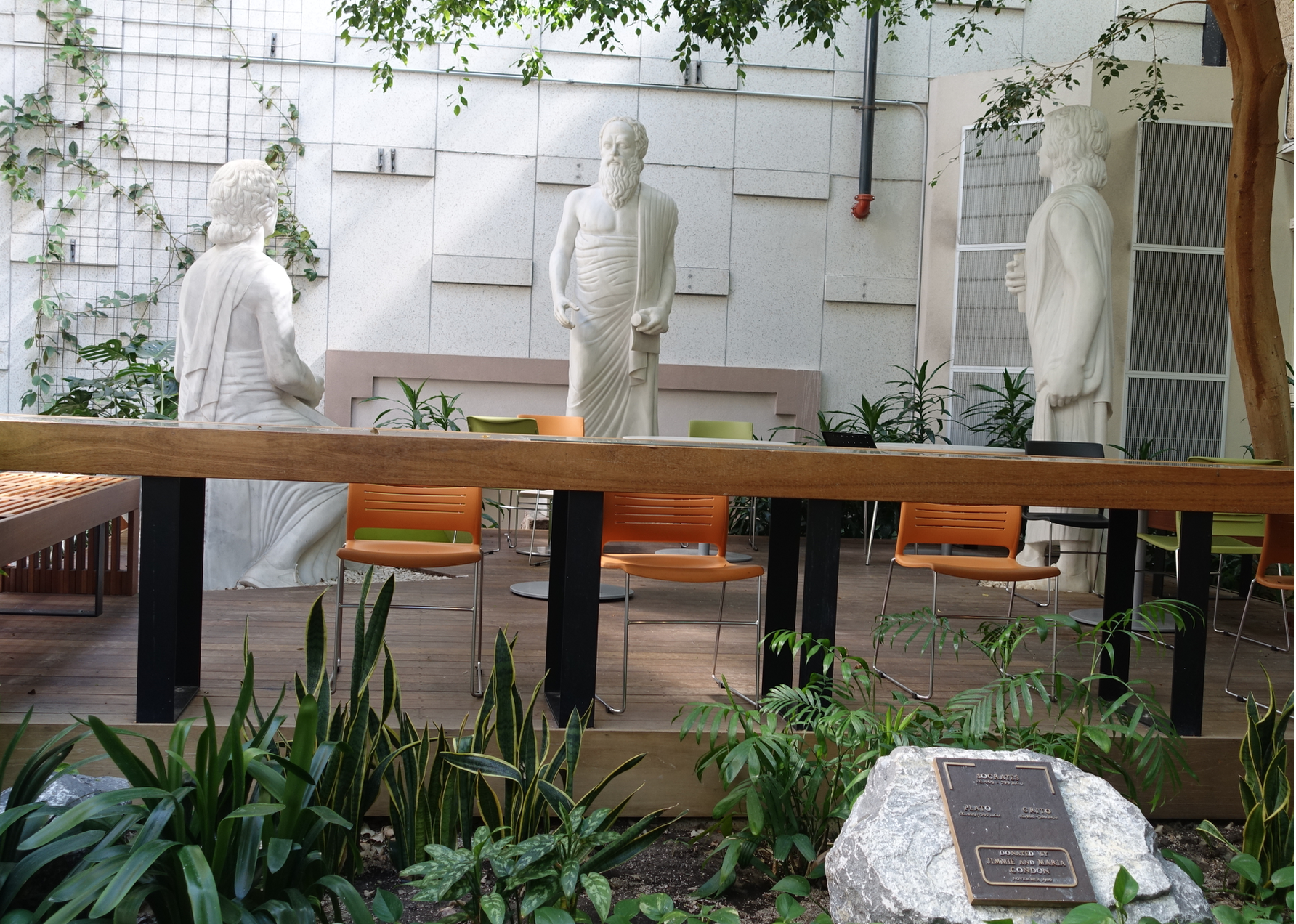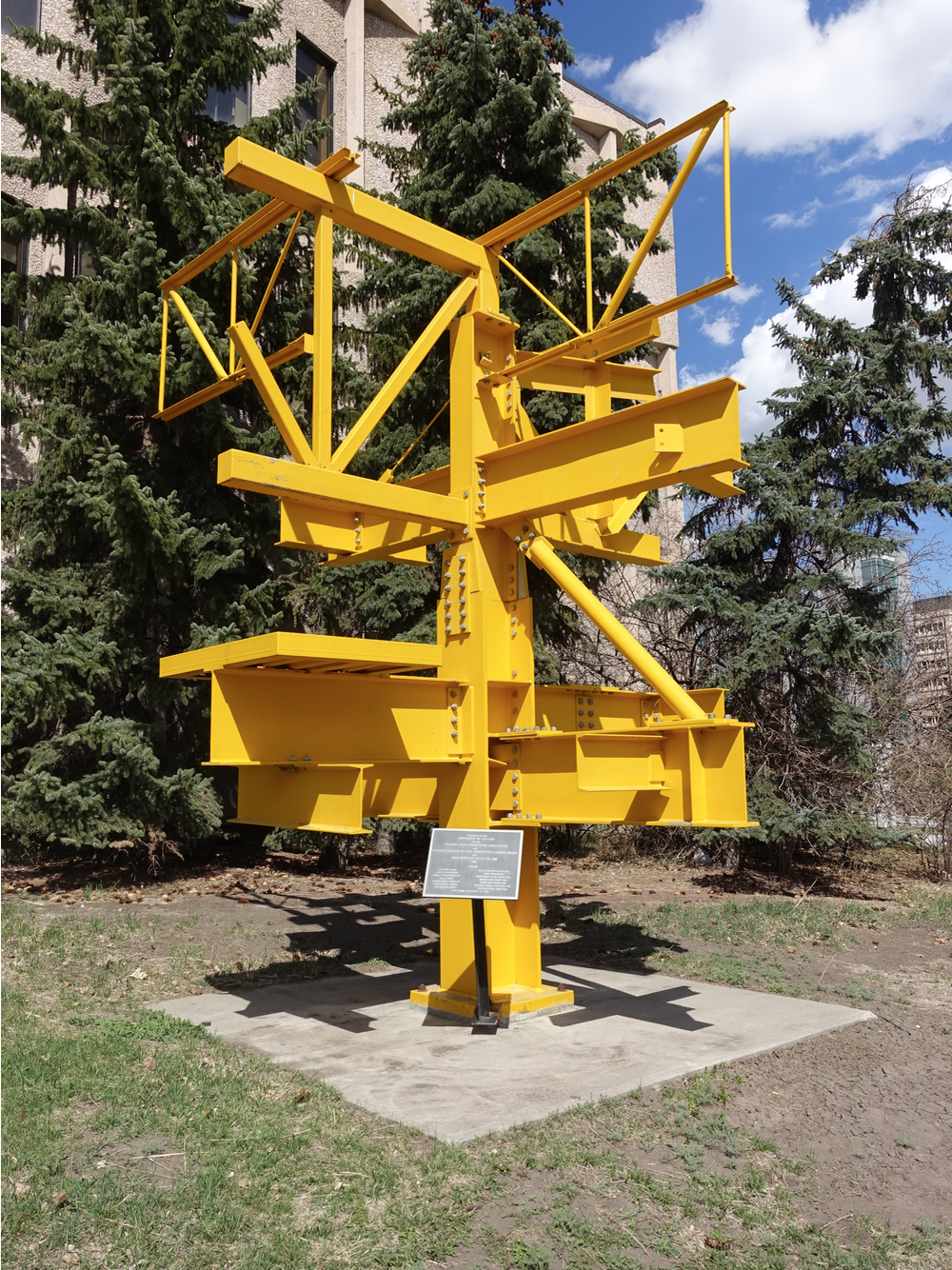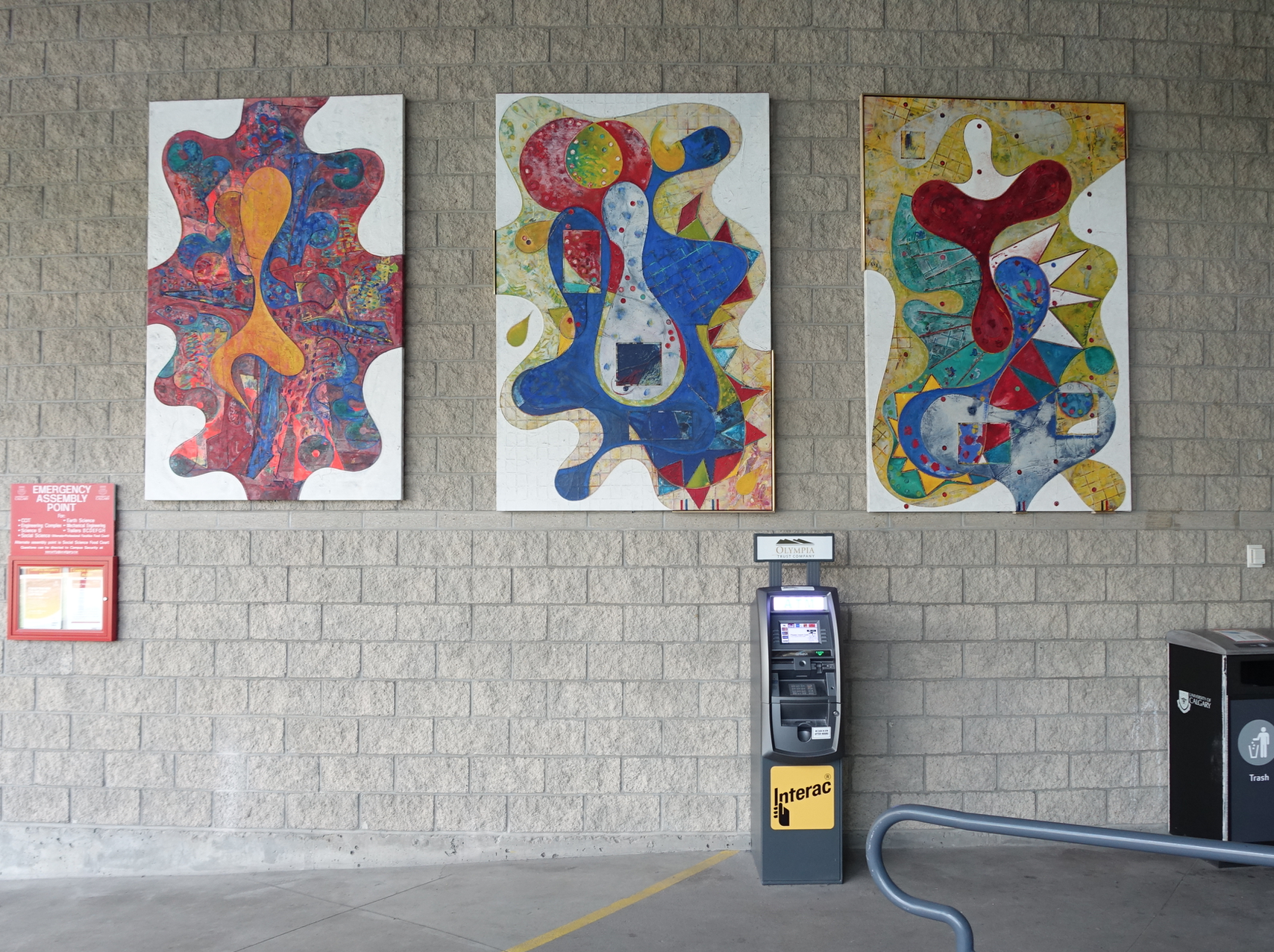University of Calgary’s Public Art Gets No Respect!
With 80+ Jane’s Walks to choose from in Calgary, it was tough to decide which one(s) to participate in. After much deliberation, we chose the University of Calgary’s Public Art tour, as we love exploring university campuses AND we love public art.
Marina Fischer, Collection Specialist, Numismatics at the University of Calgary was our very personable host. She has an art history and classics background, specializing ancient art. Fischer has been teaching art history courses for continuing education for over ten years and received an award for Continuing and Professional Education, from the Taylor Institute for Teaching and Learning. Her tour was more of a layman’s look at the University’s public art collection than academic which was fine with us.
What I found interesting was her identification of a common theme to the university’s public artworks i.e. a link between art and science. It was an astute observation; one the university might want to focus on when considering future public art pieces. In my opinion, public art collections benefit when there is a focus to the collection that adds a synergy to the art i.e. when the sum is greater than the parts.
Plato, Nikolaos Pavlopoulos, marble, University of Calgary
L- Straddle, Marc Mellon, bronze, University of Calgary
Nature is an Eternal Mystery (close-up), brozne, Reinherd Skoracki, University of Calgary
Self-Guided Tour
I have tried to format this blog so it can be used as a self-guided tour. Our tour started slowly and built to a crescendo….here we go.
(FYI: I have tried to document the tour in a manner where those interested can use this blog for a self-guided tour.
Bear / Just outside west entrance Libary
As we left the Taylor Family Digital Library building, our attention was immediately drawn to a huge black bear standing in a small grotto of trees. Created by local artist Brian Cooley, it became more interesting the closer you got as you could see the etched texture of the surface. Cooley is well known internationally for his creation of life-size life-like dinosaurs, at 1,600 lbs. and 11 ft. high, this is probably one of Cooley’s smaller pieces.
I immediately wondered, “Why a bear?” Given, the University of Calgary sports teams are called the “Dinos,” and given Cooley’s experience creating dinosaurs, it would have made more sense to have a “Dino” in the grotto. We were told Don and Ruth Taylor, huge supporters of the University’s current transformation donated the Bear. Guess I will have to ask them!
Olympic Arch / Kinesiology Building B
Next stop - Colette Whiten, Paul Kipps and Jack Diamond's 1988 sculpture "Olympic Arch” in front of the Physical Education complex. The arch is a huge plate of steel, bowed up in the center seemingly by the efforts of the four life-sized bronze humans on either side pushing and lifting. The tension reflects the struggles and efforts not only of athletes, but all humans.
Is there a political statement here? Are the figures competing against each other - or are they cooperating towards the same goal? The piece might even foreshadow the current struggles Calgary’s oil & gas companies are encountering to build or expand pipelines – the arch being the pipeline. Ironically, the piece is also known as the Trans Canada Pipeline Arch, in reference to the company who paid for the commissioned piece.
The arch sculpture has had three homes - originally it was at the entrance to the Winter Olympic athletes’ village on the University of Calgary campus, then it was moved to downtown’s Eau Claire Plaza, before landing at its current location as part of the university’s 25th anniversary in 1991.
L-Straddle / Kinesiology Building A
Walking from the Olympic Arch to the Kinesiology Building A, we stopped to admire Marc Mellon’s bronze sculpture of a gymnast jumping over a pommel horse. Called “L-Straddle,” the title references how the human figure creates a perfect “L” shape. Mellon is a well-known American sculptor who is fascinated by the shape and form of the human body in various athletic pursuits, including various gymnastic events. His work is on 40 campuses across North America. Backstory: He left a pre-medical studies program to become a sculptor; hence, his interest in the human body as art.
Once inside the Kinesiology Building, we stopped at the easy-to-miss small display case with two modest bronzes of athletes – The Athlete (1903) and The Javelin Thrower (1923). Robert Tait McKenzie, a Canadian physician, educator, sculptor, athlete and soldier, who was a pioneer of physical fitness programs and huge supporter of the Olympic games, created both. His inclusion in the University of Calgary’s art collection is very appropriate as was the artwork’s location.
Brothers of the Wind & Skate Marks / Olympic Oval
I have been in the Olympic Oval many times but before this tour I had never gone up the stairs from the lobby where a 10-foot long bronze relief titled “Brothers of the Wind”- also by McKenzie created in 1925 is mounted in the middle of the stairwell. Depicting 8 speed skating athletes drafting behind each other, it is one of McKenzie’s largest artworks and appropriately donated to the University in 1986 by a private donor.
Note: An image of Brothers of the Wind is engraved on all gold rings given to athletes who have set a world record in the Olympic Oval
But what really impressed me were the two glass windows facing south and north in the atrium by Vancouver artist, Brian Baxter. Combining both manufactured and hand-blown glass, the shapes and lines are mean to reflect “skate marks on ice.” On a bright sunny day (which Calgary has many), it creates a bright, contemporary - dare I say “church window-like” abstraction that I found uplifting.
The Spire / North Entrance, The Oval
The Spire by Charles Boyce was also created for the 1988 Olympics and serves as the grand entrance to the Olympic Oval from its north side. This huge, 20-meter-high (the equivalent of a 6-storey building) consists of five U-shaped pipes that for many, looks like a twisted paper clip – hence the nickname “The Paperclip.” Others see it as a dinosaur skeleton or mountains, while Boyce sees it "as a spaceship, symbolizing man's reaching out to explore the galaxy, and a steeple, symbolizing man's discovery of the universe within.” Personally, I love art with the ambiguity to be the catalyst for different people to see and feel different things.
For me, the U-shapes could also be seen as A-shapes, reflecting the “A” in athletes of the Olympics. The piece evokes a powerful thrust as it emerges from the ground much like a skater’s thrust from the ice (speed, figure or hockey skate). The bright red colour symbolizes passion an athlete must have to make it to the Olympics or a student to become a scholar.
Le Patineur de Vitesse / South Entrance, The Oval
Rather hidden, tucked away on an unused plaza on the east side of the Olympic Oval is Le Patineur de Vitesse (i.e. French for “speed skater”) by Germain Bergeron, a former Quebec monk turned artist. This simple whimsical metal sculpture – more a scribble drawing than a sculpture - is playful and graceful and deserves a more prominent location. It is a great hidden selfie spot.
Goddess of Democracy / MacEwan Student Centre Lobby
In 1989, Chinese students erected a 30-foot Statue of Liberty replica out of white plaster over a metal armature and styrofoam in Beijing’s Tiananmen Square facing Mao Tse-tung. A crowd of 150,000 turned out to welcome the statue. It became the symbol of the Chinese people’s desire for democracy and eventually resulted in the death of 10,000+ students when Chinese soldiers tried to remove it. Several replicas of the statue have since been created by university students around the world in sympathy with the Chinese students.
The University of Calgary’s replica (created by American artist, Thomas Marsh), is slightly larger than life-size and prominently located in the lobby of the MacEwan Student Centre.
Erected in 1995 by the Chinese Students Society, the Students’ Union, the University of Calgary and the Alliance for a Democratic China, it serves as a reminder of the “power of the people.”
Nature is an Eternal Mystery / South Entrance, EEEL Building
The Energy Environment Experiential Learning building (EEEL) is one of the University’s newest buildings and perhaps one of Calgary’s most contemporary and striking buildings architecturally. Located in a prime location at the front entrance is Reinhard Skoracki’s (born in Germany, a University of Calgary graduate) 16-foot tall bronze sculpture titled, “Nature is an Eternal Mystery” is a nude male figure (complete with genitalia) shrouded with two triangular flat planes over his head and torso, leaving only the butt and legs exposed. The leaves and tree branch sticking out of his head reference man’s needs to think more about nature. The covering of the head is perhaps a comment about humans’ blindness to our impact on nature.
Until this point, tour leader Fischer spoke very positively (often glowingly) about the university’s art collection. But in this case, she was honest in saying the piece offended her (not by the nudity), but rather she felt the obvious maleness of the figure was an inappropriate representation of humanity as equally male and female especially in relation to the new and progressive interdisciplinary science structure hosted in the Energy Environment Experiential Learning Building.
Inside EEEL Building
Once inside the EEEL building, you could easily miss the public art as they are hung in obscure spots. For example, Angela Leach’s two colourful rainbow-like paintings titled “AR Wave, Yin Yang) are hung almost at the ceiling on either side of the doorway, two floors above the ground, making it really difficult to appreciate them.
Then, there were Marjan Eggermont’s soaring steel panels etched with a delicate tree formation that hug the corner of the 3+ floor high open grandstand-like lecture hall incorporated into the building’s grand lobby. Titled “one-way ticket,” it is made up of 12 panels that combine to create a 48 ft. tall and 16 ft. wide site-specific elegant artwork that cleverly covers the elevator shaft. Though its mysterious black and white presence from the lobby floor invites you to climb the stairs to get a better look, you can never seem to quite find a good viewing point. Frustrating, but perhaps intentional given humans are always struggling to find the “right perspective” to view the world we share with each other and nature.
There is a third piece inside, David Burdeny’s two large back-lit photographs titled “Icebergs Generating Fog, Antarctic Sound,” (2007/2011) hung at the top of the wide staircase which depicts the isolation, beauty and fragility of Antarctica. Because of its location, most visitors to the building will never see it. In fact, it was not even included in our tour.
The Unknown Artist(s) / Earth Sciences & Math Sciences Buildings
Our tour then headed over the hallway on the main floor where the Earth Sciences building meets the Math Science building where a floor to ceiling artwork wraps around the corner. The wooden elements reminded me (and at least one other of the tour participants) of pieces of picnic tables. The deconstructivist, perhaps cubist arrangement of wooden elements could be a metaphor for the shifting of totemic plates of the earth over time. The spherical ceramic elements not only echo earth in colour and texture, but also seem to serve as a microscope’s eyepiece inviting one to look more closely at the art and earth. It is thought that some students made and installed the piece back in the ‘80s, but nobody knows for sure its origin.
After posted this blog, Wanda Rottenfusser contacted me to say this piece was created by John Crate and Bog Spaetgens and it was the wining entry for a Student Art Competition in 1976.
Zipper / Lobby Science Theatres Building
Katie Ohe's "Zipper" has been a mainstay on the University of Calgary campus since 1975. This kinetic art sculpture consists of two, zipper-like cylinders that revolve around each other merging and separating at they spin, similar to how a zipper does up and undoes as you move it up and down.
"Zipper” has become a good luck charm for students since its placement in the foyer of the Science Theatres over a quarter of a century ago. Rumour has it that the it is brings peace to the students, allowing them to concentrate on the ever-important studies or test writing that takes place in the adjacent classrooms. The Zipper has been stolen twice, disassembled once, coated in plastic wrap and had a car constructed around it.
Porcelain Mural / Social Sciences Building
Further along the hallway we discover a porcelain mural by Edward Drahanchuk, an Alberta College of Art and Design grad who became one of Canada’s leading ceramic artists of the late 20th century. It blends into the dark brown, earth-like brick wall it is hung on. From a distance the artwork has a primal feel with a primitive human figure surrounded by birds and other imaginary animals, but as you get closer the artwork is like a jigsaw puzzle made of hundreds of pieces.
The wall plaque says “This Wall Mural donated to the University by Hudson Bay Oil & Gas in 1976.” A little digging and a call to Drahanchuk who now lives on Quadra Island, B.C. and it turns out the piece was originally commissioned by Hudson Bay Oil & Gas for their downtown Calgary office. I was told it would have had a title, but the artist couldn’t remember what it was. In doing this research, there was also a reference to Drahanchuk being commissioned by the University in 1970 to create a piece called “Rhythm One.” I am still trying to track down where that piece might be.
Untitled (aka Prairie Chicken) / Swan Mall
Unfortunately, we did not get to see one the University’s other signature artworks, as it has been temporary removed for restoration. “Prairie Chicken” by George Norris, (a well-known Canadian artist who also did the “Crab” outside the H.R. MacMillan Space Centre in Vancouver) has been located on a hilltop in Swan Mall since 1975 in what was then the center of campus. The 18-foot high, 4.5-ton, stainless steel sculpture is officially “Untitled” but most everyone calls it the “Prairie Chicken,” as it has the look of a prairie chicken ruffling its feathers.
Atrium Awkwardness / Administration Building
Lastly, as we ended our 2-hour tour, Fischer treated us to a private viewing of the Administration Building’s Atrium (the building is normally closed on weekends) where we discovered a lush topical oasis. One of the University’s oldest buildings, it has a lovely garden atrium with funky places to sit and at the far end, a mini sculpture park with three larger-than-life statues of Socrates, Plato and Crito by Greek sculptor, Nikolaos Pavlopoulos. The plaque says “a symbol of the continuity of ancient wisdom and modern learning dedicated to the Canadian students by the Greek Canadians Jimmie and Maria Condon.” The ghost white marble figures stand proudly looking at each other as if in conversation.
The Atrium has an awkward sense of place with the modern, playful, colourful seating contrasting with the sober classical philosophers and pastoral plants. But perhaps a fitting end to our 2-hour tour given the sometimes awkward juxtaposition between the University’s art, the architecture and site selection.
There is more...
While we were on our tour, I noticed several other artworks that could have been included in our tour. The yellow structure was very interesting, but probably isn't considered to be part of the public art collection, as the plague stated it was by Calgary Steel Fabrication Association, Canada Institute of Steel Construction (Alberta Region) and Iron Workers Local #725 not by an exhibiting artist. I could not find any information on the other two pieces nearby.
Wanda Rotterfusser also identified the abstract painting in the middle photo as those of Gerry Hushlak who still teaches at the University.
Last Word
Indeed, after 50 years, the University of Calgary is still trying to define its sense of place.
Backstory
Throughout the tour, Fisher often apologized for the lack of documentation on the University’s Collection. While we were told an art committee has been formed to try to document the collection, it is surprising that a university in this day-and-age would accept artworks without getting all available documentation. It is also disappointing that often there is no information panel with the artwork - a common problem with many public collections - and disrespectful to the artist and the donor.
Documenting the art collection would be a great summer student project - or perhaps senior thesis project for an art history major. We were told a self-guided walk brochure has been in the works. Hopefully it will be completed soon.
Editor’s update: Since this blog was posted the University has created a website for some of their artworks. Link: UofC Public Art
While the University of Calgary has some interesting public artworks, my most vivid memory of the Jane’s Walk 2018 will be how poorly the University of Calgary has treated and still is treating its public art.
Below is a short video of University of Calgary's art, architecture and urban design the summarizes our tour.
If you like this blog, you will like these links:
A-mazing University of New Mexico Campus














